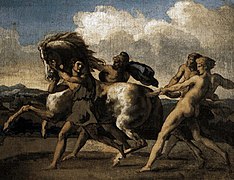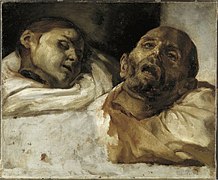Theodore Gericault
Jean-Louis André Théodore Géricault, known as Théodore Géricault (Rouen, September 26, 1791 - Paris, January 26, 1824), was a French painter, one of the main pioneering figures of romantic painting. He studied with the academic painter Pierre-Narcisse Guérin, also Delacroix's teacher. He rejected the prevailing neoclassicism, studied Rubens and began to paint directly from the model, without preparatory drawings. In Italy he studied in 1816-1818 Michelangelo and the Baroque. His commented Raft of the Medusa combined baroque design, romantic realism and uncontrolled feelings. He admired Bonington and Constable and was in England in 1820-1822, exhibiting his Raft and his horse paintings. His career, though short, was highly influential, especially for its modern themes, free playing, and depiction of the Romantic movement.The theme of the horse is a central theme of his work, early and late in his life. In particular, he copied the works of George Stubbs and Ward, and made numerous lithographs of horses and street scenes of London life.
Life and artistic training
Jean-Louis André Théodore Géricault, born in Rouen on September 26, 1791 into a wealthy family, was the son of the lawyer Jorge Nicolás Géricault and his wife Luisa-Juana-María Caruel. Thus, he never had to paint out of financial necessity, except in his later years due to various bad investments. The date on which the Géricault family moved to Paris is not known with certainty; However, it is proven that the young Théodore followed his secondary education studies at the Lycée Louis-le-Grand in the French capital. In 1808, he had already made the decision to dedicate himself entirely to painting, and entered the studio of Carle Vernet as a student (where he met his son Horace and Pierre-Narcisse Guérin), probably attracted by his paintings of horses. of that painter
Géricault's passion for horses was very early indeed, and they would end up becoming one of the most frequent images and one of the most significant symbols of his art. In 1810, he was found among the disciples of Pierre Guérni, a neoclassical painter, a follower of David. Some suppose that he wanted to submit to a more severe discipline than the one imposed by the capricious Vernet, and that, aware of his vocation for a painting far removed from the cold rules of academicism, he wanted to subject his talent to a kind of proof. Indeed, his works from those years reveal the autonomy of his inspiration and the originality of his cultural preferences with respect to neoclassical teaching: his interest in Rubens demonstrates it; the investigation of the broad pictorial field of the 16th and xvii (from Raphael to Titian to Caravaggio), made by means of a brilliant series of copies, and also the copy in the Louvre of various reliefs from late antique sarcophagi.
His first major work, Charging Hunter Officer, exhibited at the Paris Salon of 1812, reveals the influence of Rubens' style and his interest in representing a contemporary subject. This ambitious and monumental youthful success was followed by a change of direction: over the next few years Géricault produced a series of small studies of horses and knights. He exhibited the Wounded Cuirassier at the Salon of 1814, a more elaborate and less well-received work. Over the next two years he underwent a self-imposed study of construction and composition of figures, while evidencing a personal predilection for drama and expressive force.
After failing in the Rome Grand Prix competition, he decided to travel to Italy on his own. He was greatly impressed by the Italian Renaissance painters, especially Michelangelo, as well as by the Flemish Rubens. This trip to Florence and Rome (1816-1817) was prompted in part by a desire to escape the scandal caused by a romantic relationship with his aunt Alexandrine, six years his senior, whom she impregnated. In 1818 his son Georges-Hyppolyte was born, declared at birth "Suzanne's son and father unknown". On the painter's death, the boy was recognized by the father of the artist Georges-Nicolas.
This trip to Italy sparked his fascination with Michelangelo. Rome itself inspired him to prepare a monumental canvas, the Race of the Barberi Horses, a work of epic composition and abstract subject matter that promised to be "totally unparalleled in its time". Géricault never finished the painting, and returned to France.
At that time he was contacted by Colonel Ambrosio Cramer, a soldier of French origin who was fighting in the Argentine War of Independence. After having served with General San Martín in Chile, he was aide-de-camp to General Manuel Belgrano in the Army of the North. In Paris he commissioned Theodore Gericault for the well-known lithographs of both patriots.
From the beginning of his career, Géricault displayed qualities that clearly distinguish him from the neoclassical painters of the Jacques-Louis David school: indeed, he preferred to treat subjects of everyday life, elevating them to the category of heroic deeds. Showing the desperation and suffering of the people, he soon became the most representative romantic painter, but due to his independence of style and not very docile character, Géricault stayed away from large official commissions, a genre that did seduce Delacroix.
Géricault made between 1821 and 1824, a series of paintings having madmen or maniacs as models, painting from life a series of people who were treated in the asylum of the psychiatrist Jean-Étienne Esquirol. Through this series he intended to collect a repertoire of expressions of madness.
He repeatedly fell from his horse and broke his back in August 1823. He becomes bedridden and doctors diagnose osteoarticular tuberculosis. Géricault spent his last years bedridden without being able to undertake large-format paintings, although he produced various lithographs with the help of the artisan Eugène Lami. He died on January 26, 1824, after a long agony due to this fall from his horse but it is more likely than a venereal disease, which made the philosopher and art critic Élie Faure say that "Géricault died for having made love too much". His sculpted bronze figure, holding palette and brush, leans on a bas-relief reproduction of the Raft of the Medusa on his tomb in the Pere Lachaise Cemetery in Paris.
Works
- Hunter officer to the cargo, 1812, Louvre, Paris
- Strict wound coming out of the fire, 1814, Louvre, Paris
- The artillery train, h. 1814, Neue Pinakothek, Munich
- Race of free horses, 1817, Museum of Fine Arts, Lille
- Man and horse racing, Museo Thyssen-Bornemisza, Madrid
- The ox market, 1817, Fogg Art Museum, Cambridge, Massachusetts
- Horse held by slaves, 1817, Museum of Fine Arts, Ruan
- Landscape with aqueductbetween 1817 and 1820, Metropolitan Museum of Art, New York
- Troop of wounded soldiers, 1818, Fitzwilliam Museum, Cambridge, United Kingdom
- The Medusa raft, 1819, Louvre, Paris
- East Portrait, 1819-1821, Besançon Museum of Fine Arts and Archaeology
- Horse attacked by a lion1821; Louvre Museum, Paris.
- Derbi in Epsom, 1821, Louvre, Paris.
- The lime factory, 1821-1822, Louvre, Paris.
- Monomaniac of envy, h. 1821-1823, Museum of Fine Arts, Lyon.
- The cleptoman (The Crazy Killer), 1822-1823, Museum of Fine Arts, Ghent.
- Portrait of a Vandean, h. 1822-1823, Louvre, Paris.
Gallery
Contenido relacionado
Tristania
History of the comic in Spain
Abstract art















